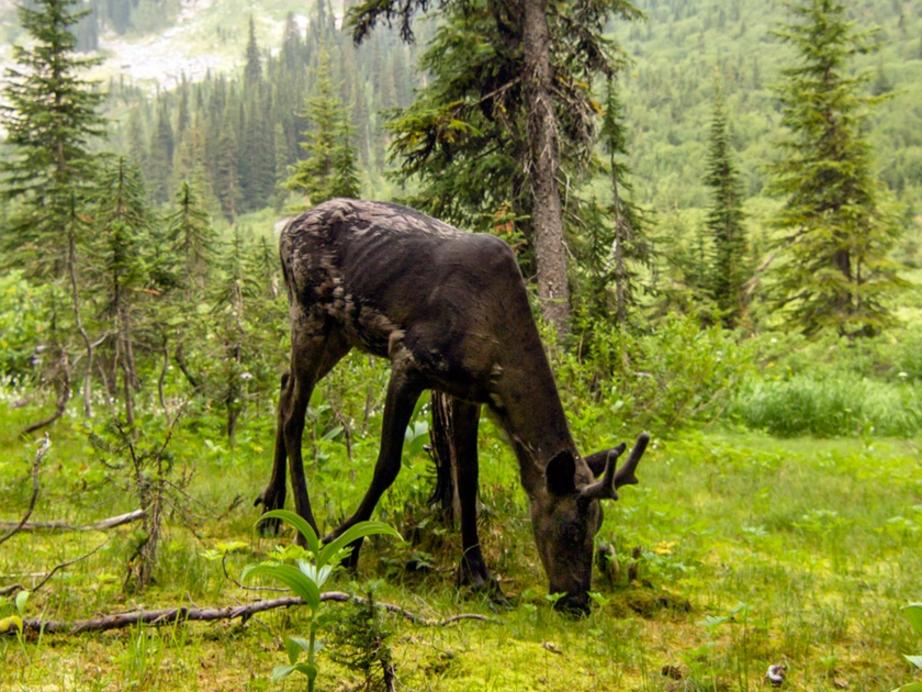Last 'Grey Ghost' caribou herd is down to just three members, all female
The alarming census, placing it at a number meaning de facto extinction, comes after years of warnings from scientists and conservation groups
The last remaining herd of cross-border mountain caribou is now effectively extinct after an aerial count found only three survived the winter, all of them female.
The alarming census of the South Selkirk population of southern mountain caribou, placing it at a number meaning de facto extinction, comes after years of warnings from scientists and conservation groups.
Government biologists twice did the head count this spring, once in ideal conditions in fresh snow to help tracking from above, and found the alarming decline, said Mark Hebblewhite, a Canadian wildlife biologist at the University of Montana and a science adviser to the federal government.
“Last year there was 11 and now there are three. And critically, there are no males this year. Without a male, it’s game over.”
The South Selkirk herd has the distinction of being among the southernmost caribou in the world and last to roam into the lower 48 states of the United States, making it a big deal south of the border where it is seen as a species extinction.
Hebblewhite said it epitomizes a problem across Canada, with caribou in B.C., Alberta, Ontario and Quebec facing a similar fate.
Caribou once roamed widely in Canada and the northern United States. Government documents tell of Aboriginal oral accounts of the beasts being so plentiful they were described as “like bugs on the land.”
It surprises no one that the range of the caribou is greatly reduced today from its historical heights.
In the 1800s, the southern mountain caribou went deep into the northern United States. The population and range of the herds has been shrinking since. The last southern mountain caribou seen in Montana, for instance, was documented in 1958.
Only the South Selkirk herd — nicknamed the Grey Ghosts for their rare sightings — still wandered across the border into Washington and Idaho.
The causes are multiple: natural predators, overhunting, climate change, loss of old growth forest and disturbance of their habitat by human activity — from logging and oil and gas development to snowmobiling.
Southern mountain caribou need large tracts of interconnected habitat of old-growth forest where they can separate themselves from predators, particularly wolves, bears and cougars. Roads, trails and seismic lines that divide the landscape spoil that protection.
This tragic loss of all but three caribou in the South Selkirks herd has to be a wake-up call
Environmental and conservation groups call the loss of the South Selkirk a disaster and a warning for the remaining strains of the caribou in Canada.
“This tragic loss of all but three caribou in the South Selkirks herd has to be a wake-up call,” said John Bergenske, conservation director with Wildsight, a conservation advocacy group. “This is an emergency and our mountain caribou can’t wait any longer for planning without action.”
Efforts at salvation have been tried.
Caribou from other areas were added to the South Selkirks in the late 1980s and 1990s. Over 11 years, more than 100 mountain caribou were transplanted south, bolstering it temporarily.
Maternity pens were built to protect pregnant caribou and newborn calves from predators during and after calving.
The B.C. government protected about 2.2 million acres of caribou habitat from forestry and snowmobiling.
First Nations groups imposed their own bans on their members hunting caribou, a traditional activity. And lawsuits forced added protective measures from government for various subgroups of the mountain caribou, leading to curtailing natural gas, petroleum and mineral tenures in affected areas.

File photo of the isolated population of mountain caribou inhabiting the Selkirk Mountains of southern B.C. The herd is now down to three females. Handout
Even culling of wolves — a controversial project called aerial wolf removal, meaning sniping wolves from helicopters — is in place.
“The functional loss of this herd is the legacy of decades of government mismanagement across caribou range,” said Hebblewhite. “It is completely unsurprising. Bad things happen to small populations,” he said. “We are facing this across the country.”
As if to highlight the cumbersome bureaucracy of government intervention for endangered wildlife, the federal government last month announced it will be rewriting a draft agreement with British Columbia after negotiations with First Nations to plan survival strategies for the remaining southern mountain caribou. That hardly offers encouragement for quick results.
On Friday, the B.C. government announced $2 million to aid in caribou habitat restoration.
“There were about 40,000 caribou in B.C. in the early 1900s. Today, there are only about 19,000 caribou left,” Doug Donaldson, the province’s minister in charge of natural resources, said in a speech to B.C. Wildlife Federation’s annual conference. “We need to do whatever we can to help enhance and recover caribou habitat to rebuild the numbers of this iconic species.”
Southern mountain caribou are one of six geographically distinct populations in Canada of the Woodland caribou. A typical adult weighs between 110 and 210 kilograms.
A Canadian government estimate of the overall number of southern mountain caribou in Canada in 2014 was 5,800. It is estimated to be 3,800 this year.

